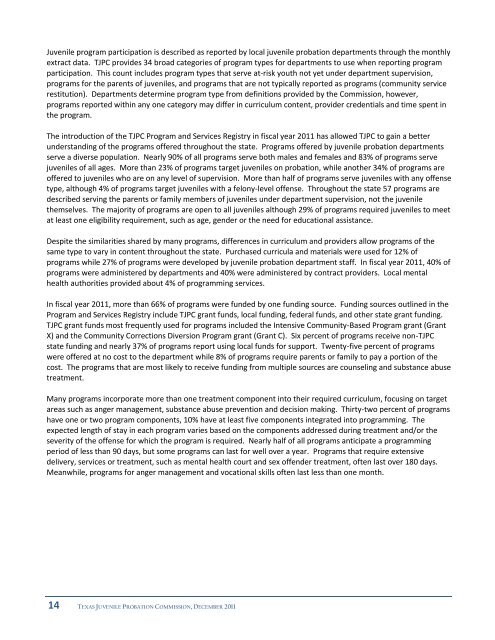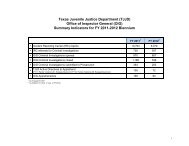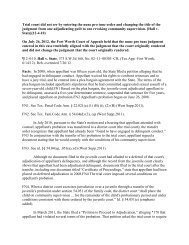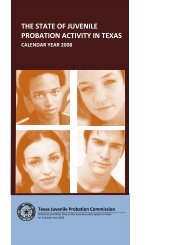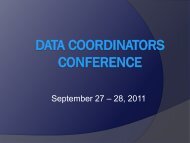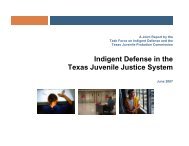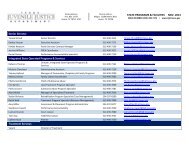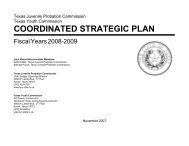report from the Juvenile Probation Commission - Texas Juvenile ...
report from the Juvenile Probation Commission - Texas Juvenile ...
report from the Juvenile Probation Commission - Texas Juvenile ...
Create successful ePaper yourself
Turn your PDF publications into a flip-book with our unique Google optimized e-Paper software.
<strong>Juvenile</strong> program participation is described as <strong>report</strong>ed by local juvenile probation departments through <strong>the</strong> monthlyextract data. TJPC provides 34 broad categories of program types for departments to use when <strong>report</strong>ing programparticipation. This count includes program types that serve at-risk youth not yet under department supervision,programs for <strong>the</strong> parents of juveniles, and programs that are not typically <strong>report</strong>ed as programs (community servicerestitution). Departments determine program type <strong>from</strong> definitions provided by <strong>the</strong> <strong>Commission</strong>, however,programs <strong>report</strong>ed within any one category may differ in curriculum content, provider credentials and time spent in<strong>the</strong> program.The introduction of <strong>the</strong> TJPC Program and Services Registry in fiscal year 2011 has allowed TJPC to gain a betterunderstanding of <strong>the</strong> programs offered throughout <strong>the</strong> state. Programs offered by juvenile probation departmentsserve a diverse population. Nearly 90% of all programs serve both males and females and 83% of programs servejuveniles of all ages. More than 23% of programs target juveniles on probation, while ano<strong>the</strong>r 34% of programs areoffered to juveniles who are on any level of supervision. More than half of programs serve juveniles with any offensetype, although 4% of programs target juveniles with a felony-level offense. Throughout <strong>the</strong> state 57 programs aredescribed serving <strong>the</strong> parents or family members of juveniles under department supervision, not <strong>the</strong> juvenile<strong>the</strong>mselves. The majority of programs are open to all juveniles although 29% of programs required juveniles to meetat least one eligibility requirement, such as age, gender or <strong>the</strong> need for educational assistance.Despite <strong>the</strong> similarities shared by many programs, differences in curriculum and providers allow programs of <strong>the</strong>same type to vary in content throughout <strong>the</strong> state. Purchased curricula and materials were used for 12% ofprograms while 27% of programs were developed by juvenile probation department staff. In fiscal year 2011, 40% ofprograms were administered by departments and 40% were administered by contract providers. Local mentalhealth authorities provided about 4% of programming services.In fiscal year 2011, more than 66% of programs were funded by one funding source. Funding sources outlined in <strong>the</strong>Program and Services Registry include TJPC grant funds, local funding, federal funds, and o<strong>the</strong>r state grant funding.TJPC grant funds most frequently used for programs included <strong>the</strong> Intensive Community-Based Program grant (GrantX) and <strong>the</strong> Community Corrections Diversion Program grant (Grant C). Six percent of programs receive non-TJPCstate funding and nearly 37% of programs <strong>report</strong> using local funds for support. Twenty-five percent of programswere offered at no cost to <strong>the</strong> department while 8% of programs require parents or family to pay a portion of <strong>the</strong>cost. The programs that are most likely to receive funding <strong>from</strong> multiple sources are counseling and substance abusetreatment.Many programs incorporate more than one treatment component into <strong>the</strong>ir required curriculum, focusing on targetareas such as anger management, substance abuse prevention and decision making. Thirty-two percent of programshave one or two program components, 10% have at least five components integrated into programming. Theexpected length of stay in each program varies based on <strong>the</strong> components addressed during treatment and/or <strong>the</strong>severity of <strong>the</strong> offense for which <strong>the</strong> program is required. Nearly half of all programs anticipate a programmingperiod of less than 90 days, but some programs can last for well over a year. Programs that require extensivedelivery, services or treatment, such as mental health court and sex offender treatment, often last over 180 days.Meanwhile, programs for anger management and vocational skills often last less than one month.14 TEXAS JUVENILE PROBATION COMMISSION, DECEMBER 2011


